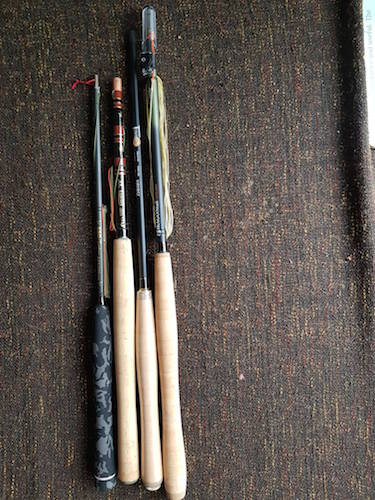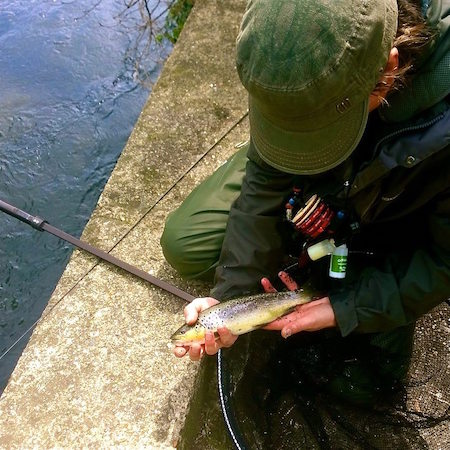Paul Williams shares what he has learnt as a newcomer to Tenkara fishing
A few years ago I was at the Sportfish Reading Show which was quite local to me and normally worth an afternoon of my time to see new products in the flesh and to have a look at Tyers Row. As I stood watching the pike fly demonstration I noticed a mention of Tenkara in the show information. I had heard of Tenkara but knew very little about it and what I had heard sounded rather a frustrating way to fish, if I’m honest. I recall friends mentioning it in a similar vein with frustrated mentions along the lines of “once you're fed up not being able to reach the fish you're after maybe you could use the rod as a wading stick”. Curiosity got the better of me though and I went to have a look at the rods. At first glance they look like a whip pole and, to me, not very impressive. The information on how to use the rod focussed on small streams and mentioned words like Kebari and Amago; this all set up the Tenkara in my mind as a very niche application and with the terminology all being rather foreign. It seemed like a lot of work for little reward and thus it was dismissed and I put out of mind and I moved along to look at the Sage rods that I have long aspired to own.
Over the next couple of years I heard a bit more about Tenkara and, as with most things related to fishing the fly, I paid attention and assimilated information I came across in the hope that that it might be applied in the future.
 Around two years ago I moved from my home area of Oxford and found myself near Morden in south London. I detest hustle and bustle and the idea of living in such an area filled me with dread (the things we do for love!). One of the virtues of the new location was the River Wandle. I had heard of this river many times over the years and I was a keen follower of the Urban Trout blog.
Around two years ago I moved from my home area of Oxford and found myself near Morden in south London. I detest hustle and bustle and the idea of living in such an area filled me with dread (the things we do for love!). One of the virtues of the new location was the River Wandle. I had heard of this river many times over the years and I was a keen follower of the Urban Trout blog.
A friend of mine, local to the area, took me on my first day to the river. I spotted trout plenty of times but they were so spooky neither myself or another much more accomplished and seasoned angler got even near hooking one. Over the following days I read as much as I could about these Wandle fish and learnt that upstream dry was the traditional choice and that a lot of bait goes into the Wandle in the form of bread and corn. After another couple of outings I had still to hook a trout at all and I was beginning to lost a little heart and confidence.
The next thing that happened didn’t do much for my prospects as I had a rather nasty motorcycle accident and broke nearly all my ribs, my shoulder and my shoulder blade on my left. My right arm below the elbow was now held together with two metal plates from wrist to elbow both sides. Now this of course rather hampered the fishing for me over the next few months and I was in a very unhappy place due to a lot of muscular and nerve damage, let alone the broken bones which seemed to be the smallest of the issues. What I did next was actually the best thing I could have done for my fishing, and that was to not fish. Okay I know what you’re thinking “How can you catch fish if you don’t fish for them?” Well in actual fact it was a blessing and I shall explain why.

While unable to fish due to injuries, I took to walking along the river and observing the fish without worrying about how I was going to catch them. This was the single best thing to improve my fishing I think I have ever done. I would often spot fish and from a distance watch what they did. Over the months this allowed me to note where the fish tended to group at different times of the day, where the fish sat in high or low water and to see how often the fish rose to the surface to take food from the top of the water. Their behaviour showed me that the fish spent so much time grubbing around on the water's lower layers and that nymphing was probably going to be the best approach, as logic dictated that if they spent more time feeding that way then this meant I could be offering them flies more likely to be taken more of the time.
How does this relate to Tenkara I hear you ask? Well it was one of those chance situations. I had spent time reading up and learning about nymphing by various methods and purchased a Hends Camou French leader which I had already had limited success with from the very first time I used it. Out on a day’s fishing with my good friend David who was currently experimenting with a little Tenkara Zoom rod he recently purchased, I had taken him to one of the areas where I had seen a lot of fish. David had been telling me about his new rod while we planned the day's fishing and how he was using a Titanium leader to allow him to cut through the wind. Now my thinking was that surely Titanium lines had no place in this ancient mystical art I had heard about but David was an advocate of the virtues of it. I was also impressed with the tiny little rod he brought along, which was nothing like any Tenkara rod I had seen, with its camo grip and much more modern look and feel.
As David fished I stood back and watched. He was struggling to get down to the fish we were watching and decided to put on a slighty heavier bead head nymph and was quickly rewarded with a rudd. Buoyed on by his first Wandle fish David attempted to get to the trout. A few missed takes followed by a more positive one and David was holding his first Tenkara trout from the Wandle.

Over the next few days I took to learning more about the Tenkara and I purchased an Esoteric Tackle Tenkara Zoom Fishing rod 245cm/206cm (8'/6'9") with a spare tip. Soon after it arrived I headed out to the river to try it. Admittedly, the first few casts landed nowhere near where I intended but by more luck than judgement I was already holding a small chub and following that, some dace and rudd. It took me a couple more outings to land my first Tenkara trout and I could at last see the application of Tenkara as a useable format. Not quite on the narrow mountain streams I had heard referenced over and over but on an urban stream with urban trout.
As I learnt more and more about nymphing, I discovered that Tenkara was actually an extremely good method to practice as the extra weight of the reel and line were eliminated. Euro nymphing could be effectively done on a Tenkara rod.

I now own a number of Tenkara rods all with their own particular attributes but probably too many in reality. I also own a lot of fly rods and would never consider giving up one approach in favour of the other.
So what have I learnt? Well it’s kind of obvious when you look at it objectively, the more you focus on honing a particular method the more success you are likely to enjoy and that you don’t have to learn Japanese or even use Tenkara flies to use Tenkara. For me Tenkara is about going back to basics and examining the bare minimum you can use when fishing. The uncomplex and compact nature of the rods mean you can also travel light.
It has been an enjoyable journey so far and I am leaning more with each visit to the water.